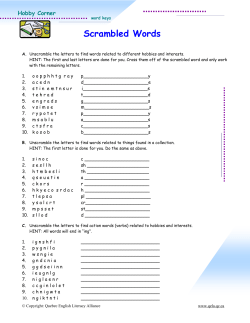
Questions Problem Set 3
CS578/STAT590: Introduction Machine Learning
Fall 2014
Problem Set 3
Handed Out: Nov 3
Due: Nov 18
Questions
1. Fitting an SVM classifier by hand (source: Machine Learning, a probabilistic perspective. K Murphy)
√
Consider a dataset with 2 points in 1d1 : (x1 = 0, y1 = -1) and (x2 = 2,√y2 = 1).
Consider mapping each point to 3d using the feature vector φ(x) = [1, 2x, x2 ]
(This is equivalent to using a second order polynomial kernel). The max margin
classifier has the form:
min ||w||2
s.t.
y1 (wT φ(x1 ) + w0 ) ≥ 1
y2 (wT φ(x2 ) + w0 ) ≥ 1
(1)
(2)
(3)
(a) Write down a vector that is parallel to the optimal vector w. Hint: recall that
w is perpendicular to the decision boundary between the two points in the 3d
feature space.
(b) What is the value of the margin that is achieved by this w? Hint: recall that the
margin is the distance from each support vector to the decision boundary. Hint
2: think about the geometry of 2 points in space, with a line separating one from
the other.
(c) Solve for w, using the fact the margin is equal to 1/||w||.
(d) Solve for w0 using your value for w and Equations 1 to 3. Hint: the points will
be on the decision boundary, so the inequalities will be tight.
(e) Write down the form of the discriminant function f (x) = w0 + wT φ(x) as an
explicit function of x
2. We define a concept space C that consists of the union of k disjoint intervals in a real
line. A concept in C is represented therefore using 2k parameters: a1 < b1 < a2 < b2 <
... < ak < bk . An example (a real number) is classified as positive by such concept iff
it lies in one of the intervals. Give the VC dimension of H (and prove its correctness).
3. The Gradient Descent (GD) algorithm
(a) Write in one sentence: what are the hyper parameters of the GD algorithm.
(b) Write in one sentence: What is the difference between l1 and l2 regularization.
1
Note that xi is the i-th one dimensional input example , yi is the output
1
2
(c) Write down the gradient descent algorithm applied to hinge loss with l2 regularization.
(d) The same as above, but using the l1 regularization. Note: the l1 norm is convex
but not differentiable.
Programming Assignment
In this part of the assignment you are required to implement the GD algorithm and observe
its performance in practice by running the algorithm over the credit card approval dataset.
1. Feature Representation As in the previous assignment, your implementation should
consider three variations of the feature set as described below 2
(1) original attributes e.g., {(a = A1 ), (b = B1 ), (c = C1 )}
(2) feature pairs e.g., {(a = A1 ; b = B1 ), (a = A1 ; c = C1 ), (b = B1 , c = C1 )}
(3) use all the features in 1-2.
2. Implementation Implement the GD algorithm by completing the function
GD(maxIterations, regularization, stepSize,lmbd, featureSet). The first argument determines the number of training iterations the algorithm will perform over the dataset.
The regularization argument determines which regularizer the GD algorithm should
use, possible values are {l1, l2}. The stepSize argument (η) determines the step size
taken by GD algorithm. The argument lmbd (λ) determines the impact of the regularizer compared to the training loss. The featureSet argument determines which feature
representation will be used. The argument takes integer values ({1,2,3}) corresponding
to three feature representations described above.
3. Experiments In addition to the code implementation you should also submit a short
report describing the results of your algorithm. For each feature representation, report
the accuracy, precision, recall and F1 as described in class, over the training, validation
and testing sets used in the previous assignment. Your report should include the values
of hyper parameters and an explanation of how was the value picked for each feature
representation. You should specifically address the impact your choice of regularizer
has on each feature set.
2
Examples: given three attributes a,b,c each taking different values, we denote the feature corresponding
to each value assignment using parentheses e.g., (a = A1 ) , when the feature is defined over multiple attributes
we use ”;” to denote the pair of attributes e.g., (a = A1 ; b = B1)
© Copyright 2025





















